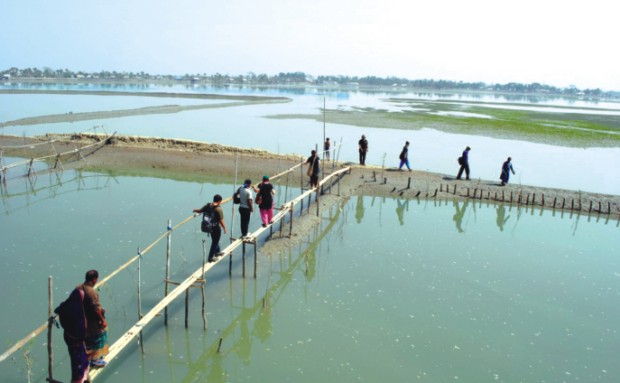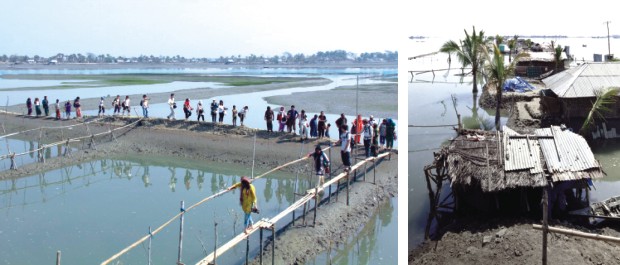Musings
 The coast is our teacher The coast is our teacher
Canadians in Satkhira
Sepideh Soltaninia
Bangladesh is not a popular exchange destination for most North American students. An exchange is often completed at European institutions in cities like London, Amsterdam or Paris--locations that entice images of a semester spent among medieval architecture, European cuisine and world-renown nightlife. Dhaka, with its potted streets, spicy food and quiet nights, is far from being a sought-out choice by students. Hence, when we (seven Development Studies students from the University of Ottawa in Canada) decided to head to Bangladesh's bustling capital for four months, we had no idea what to expect. Now, over three months since we arrived, Dhaka has become our new home. We've grown accustomed to the bumpy rickshaw rides and persistent traffic, and have learnt to embrace the city despite its dust and unwavering pollution. As international development students, we moved to Dhaka to learn about the developing world from its streets, students and scholars. We strongly believe that the complexity of this country, like all others, cannot be captured in Western textbooks and explained within a Canadian classroom. It must be observed and experienced, stumbled upon and confronted, in order to be genuinely understood.
 |
On the way to Satkhira.
Photos: courtesy |
When we first arrived at BRAC University to start our semester, we all made the decision to participate in a disaster management course. It was through this course that we ventured to Satkhira in the beginning of March to observe the dynamics surrounding disasters. We were joined by 11 students from the Postgraduate Programmes in Disaster Management at BRAC University and 10 Japanese students from J.F. Oberlin University in Tokyo.
The bus ride to Satkhira was a haze of incessant honking, weaving and passing of cars that would have left any traffic abiding North American fearing for their life. After ten hours, we arrived in Satkhira where we rested for the night and awoke to a dazzling sunrise across the open horizon, a quiet reminder of the rural beauty of Bangladesh.
That day, dressed in our shalwar kameezes and equipped with our notebooks, we headed to the Adarsha Gram in Padmapukur Union--a community that was severely affected by cyclone Aila in May 2009. This village, which was once the site of destruction, is now uniquely distinguishable due to the tall cyclone resilient home that towers above the community. This home, which was built and designed by the community in cooperation with BRAC, BRAC University's Department of Architecture and the UNDP, is a pilot project meant to reduce the families' vulnerability to cyclones.
We travelled across the community talking to individuals regarding their journey of post-cyclone reconstruction in the past 19 months. A 54-year-old man we spoke to had decided to stay home during the cyclone, along with his wife and elderly mother. After their home began to flood, they proceeded to tie themselves to nearby trees to save themselves from being washed away. They returned to their homestead to find both their house and their livelihood, a small grocery store, completely destroyed. The man continued to discuss his family's struggles and at one point he left only to return with several books whose covers adorned the names of several microcredit organisations. The books, although crinkled, appeared completely intact and continued to be legible. The only portion of these logs that appeared to have sustained great water damage was a photograph of the man--now completely unrecognisable. The man picked up the photograph, tucked within the pages of one of the books and examined it silently, before chuckling and showing the crowd of community members who had come to join our discussion. It appeared that out of everything that had washed away in the storm and was now lost, a faceless record of the families’ debt still remained.
 |
Students of BRAC University visiting the Aila-affected areas in Satkhira. Photos: courtesy |
Another element of our discussions that highlighted the vulnerabilities of people living in the community was the omnipresence and pervasive nature of the nearby embankment. Only a short boat ride away and easily visible with the naked eye, the embankment has become a constant point of frustration for the community. It was the breaking of the embankment that led to the level of devastation that the community experienced in May 2009; however, since so many families have become dependent on the embankment for their livelihoods (mainly shrimp cultivation and services for shrimp farmers) its reconstruction has become a major need for the community. It was apparent that the original building of an embankment, an unnatural structure in a vulnerable area, has led to a dependence that is dangerous, yet difficult to end. In a perfect situation, no embankment would be rebuilt and new livelihoods would flourish using the natural ecosystem. However, due to the economic, social and physiological constraints presented by the cyclone, learning a completely new way of life would have been unimaginable.
In our short visit to Adarsha Gram, we became acutely aware of the vulnerabilities that exist in the lives of cyclone-affected communities. What we remember most vividly is the command people assumed over their own. In a country where international donors and organisations coupled with NGOs play such a prevalent role, it was refreshing and eye opening to observe the changes made by individuals. In the future, when faced with yet another lecture regarding natural disaster in the developing world, we'll be reminded of the distinct experiences faced by the people we met in the Adarsha Gram. Such enlightening opportunities to witness the strength of people in the development process are what make Bangladesh a truly unique place to study.
|
Copyright
(R) thedailystar.net 2011 |
